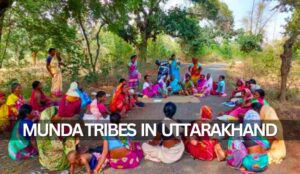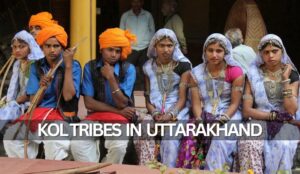“Discover the breathtaking beauty of Sunderdhunga Glacier! 🏔️ Unveil the hidden gem nestled in Uttarakhand’s Himalayas. 🌄 #SunderdhungaWonder”
About Sunderdhunga Glacier:
- Location: Sunderdhunga Glacier is situated in the Kumaon region of Uttarakhand, India, within Nanda Devi National Park.
- Geography: Nestled amidst the Indian Himalayas, the glacier is surrounded by towering peaks, lush valleys, and serene landscapes.
- Formation: Sunderdhunga Glacier is a result of centuries of snow accumulation and ice movement.
- Size: It spans several kilometers and contributes to the Alaknanda River system.
History of Sunderdhunga Glacier:
- Ancient Significance: Historically, the glacier area was frequented by traders and travelers due to its location on the ancient trade routes.
- Local Lore: The region holds cultural significance in local legends and traditions, adding to its allure.
- Exploration: European explorers discovered the glacier during the British colonial era, sparking interest in its unique geological features.
- Environmental Changes: Over the years, the glacier has undergone changes due to climate shifts, impacting the local ecosystem and water sources.
Sunderdhunga Glacier: Location and Exploration
Location:
- Sunderdhunga Glacier is situated in the Kumaon region of Uttarakhand, India.
- Found within the Nanda Devi National Park, it is embraced by the majestic Indian Himalayas.
Geography and Formation:
- The glacier is a product of centuries of snow accumulation and ice compaction.
- Its breathtaking surroundings comprise soaring peaks, verdant valleys, and tranquil landscapes.
Size and Contribution:
- The glacier spans several kilometers, adding to the grandeur of the region.
- It plays a vital role in feeding the Alaknanda River system, a crucial water source.
Historical and Cultural Significance:
- Once frequented by traders and travelers, the glacier was a crossroads on ancient trade routes.
- The region holds deep cultural importance, woven into local legends and traditions.
Exploration and Discovery:
- During the British colonial era, European explorers stumbled upon this natural wonder, uncovering its unique geological attributes.
- Their discoveries ignited curiosity and interest in the glacier’s formation and evolution.
Environmental Dynamics:
- The glacier has been impacted by changing climate patterns, leading to noticeable transformations over time.
- These shifts affect the delicate ecosystem and water resources, necessitating environmental awareness and conservation efforts.
Sunderdhunga Glacier: Reasons for its Popularity
Natural Magnificence:
- The glacier’s stunning beauty is a magnet for adventurers and nature enthusiasts alike.
- Towering Himalayan peaks, serene landscapes, and lush valleys contribute to its visual allure.
Unique Geological Formation:
- The glacier’s origin through centuries of ice accumulation makes it a captivating geological marvel.
- Its creation process and the resulting landscape intrigue geology enthusiasts.
Historical and Cultural Significance:
- The glacier’s historical role as a trade route crossroads lends it cultural and historical importance.
- Local legends and traditions further enrich its significance, attracting those interested in cultural heritage.
Activities and Attractions in Sunderdhunga Glacier
Trekking and Adventure:
- The region offers thrilling trekking opportunities, attracting adventure seekers.
- Trekking routes pass through breathtaking scenery, providing a chance to witness nature’s grandeur.
Flora and Fauna Exploration:
- The area’s diverse flora and fauna appeal to nature lovers and wildlife enthusiasts.
- Unique plant species and elusive Himalayan wildlife add to the allure of exploration.
Photography and Visual Delight:
- Photographers find a paradise in capturing the glacier’s panoramic vistas, flora, and fauna.
- The play of light, shadows, and reflections offer endless creative possibilities.
Camping and Nature Immersion:
- Camping near the glacier provides an immersive experience in the heart of nature.
- The quietude and serenity of the surroundings make it a perfect retreat from urban life.
Environmental Awareness and Conservation:
- Sunderdhunga Glacier’s popularity also underscores the importance of conservation efforts.
- Visitors are often inspired to support initiatives aimed at preserving this fragile ecosystem.
Sunderdhunga Glacier: Essential Information
Glacier Insights:
- Sunderdhunga Glacier graces the Kumaon region of Uttarakhand, India, nestled within Nanda Devi National Park.
- Its awe-inspiring vistas are composed of majestic peaks, verdant valleys, and serene landscapes.
Unique Geological Formation:
- This glacier is a product of centuries of snow accumulation and gradual ice movement.
- The process of its formation and its geological attributes make it an intriguing subject for study.
Historical and Cultural Significance:
- With a past as a crossroads for traders and travelers, the glacier holds historical importance.
- Local myths and traditions weave cultural richness into its natural beauty.
Reaching Sunderdhunga Glacier: How-To Guide
Access Points:
- The trek to Sunderdhunga Glacier typically starts from a village called Sankri in Uttarakhand.
- Trekkers embark on a journey through charming villages, dense forests, and alpine meadows.
Trekking Routes:
- The trail offers multiple routes, each with its own levels of difficulty and attractions.
- Trekking options include crossing rivers, ascending heights, and traversing glaciers.
Permits and Regulations:
- A permit from the forest department is usually required for trekking in Nanda Devi National Park.
- Adhering to eco-friendly practices and park regulations is vital to preserve the delicate ecosystem.
Expert Guidance:
- Engaging a local guide or joining trekking groups enhances safety and navigation.
- Experienced guides provide insights into the region’s history, culture, and environment.
Travel Tips for Exploring Sunderdhunga Glacier
Plan and Prepare:
- Research thoroughly about the trek, routes, and necessary permits before embarking.
- Pack essentials like sturdy footwear, warm clothing, rain gear, and a first aid kit.
Physical Fitness:
- Prior fitness preparation helps cope with the trek’s challenges, including altitude changes.
- Regular exercise, cardio, and strength training can aid in acclimatization.
Stay Hydrated and Nourished:
- Carry ample water and energy-rich snacks to stay hydrated and energized.
- Local cuisine and hot beverages offer comfort and sustenance during the trek.
Respect Nature and Culture:
- Follow the ‘Leave No Trace’ principle, ensuring minimal impact on the environment.
- Respect local customs, traditions, and wildlife to promote sustainable tourism.
Safety First:
- Ensure safety by using proper trekking gear, helmets, and safety ropes, if necessary.
- Be cautious near steep terrain, river crossings, and while navigating glaciers.
Connect with Locals:
- Interact with locals to learn about the region’s history, culture, and lifestyle.
- Support local communities by purchasing handicrafts or souvenirs.
Best Time to Visit Sunderdhunga Glacier
Spring (May – June):
- Pleasant weather with clear skies makes trekking enjoyable.
- The landscape blooms with wildflowers, adding to the scenic beauty.
Fall (September – October):
- Post-monsoon, the region is rejuvenated, offering clear views and lush surroundings.
- Moderate temperatures provide comfortable trekking conditions.
Dining Options Around Sunderdhunga Glacier
Local Cuisine Delights:
- Savor traditional Kumaoni dishes at nearby villages or lodges.
- Try local specialties like “bhatt ki churkani” or “aloo ke gutke” for an authentic experience.
Simple Village Eateries:
- Villages en route might offer basic food options, providing a taste of local life.
- Enjoy homemade meals that reflect the region’s flavors and ingredients.
Pack and Carry:
- Due to limited dining facilities, carry non-perishable snacks, energy bars, and instant meals.
- Light and easily portable food can be convenient during long treks.
Nearby Attractions and Activities
Village Exploration:
- Visit Dhakuri, a charming village on the trek route, offering insights into local culture.
- Interact with residents and observe their way of life amid stunning natural beauty.
Pinder Valley Exploration:
- Explore the picturesque Pinder Valley, which houses the glacier and captivating landscapes.
- The valley’s beauty and tranquility make for rewarding treks and photography.
Adi Kailash Range:
- Nearby, the Adi Kailash Range entices with its panoramic views and sacred significance.
- It’s a haven for spiritual seekers and nature enthusiasts alike.
Nearby Places of Sunderdhunga Glacier:
Khati Village:
-
- Khati, a charming village, is often the starting point for treks to Sunderdhunga Glacier.
- Experience local culture, hospitality, and stunning views as you begin your journey.
Loharkhet:
-
- Another village on the route, Loharkhet offers a glimpse of rural life in the Himalayas.
- Begin your trek surrounded by lush landscapes and quaint surroundings.
Dhakuri:
-
- Dhakuri is a picturesque meadow that serves as a popular trekking halt.
- Enjoy panoramic views of the surrounding peaks and rejuvenate amidst nature’s beauty.
Song Village:
-
- A serene hamlet along the trail, Song provides a peaceful atmosphere for trekkers.
- Interact with locals and soak in the tranquil ambiance as you continue your journey.
Kafni Glacier:
-
- For the more adventurous, Kafni Glacier is another trekking destination in the region.
- Marvel at the glacier’s grandeur and explore the rugged terrain of this pristine landscape.
Conclusion:
Sunderdhunga Glacier stands as a breathtaking testament to the natural wonders of the Himalayas. Nestled within the picturesque Nanda Devi National Park, this glacier offers a unique blend of geological marvels, cultural significance, and adventure. From its historical role as a crossroads for traders to its role in feeding vital river systems, Sunderdhunga Glacier is a treasure trove of experiences. Whether you’re an explorer seeking adventure, a nature enthusiast captivated by its beauty, or a culture seeker intrigued by its stories, this glacier’s allure is undeniable.
FAQs (Frequently Asked Questions) about Sunderdhunga Glacier:
1. What is the best time to visit Sunderdhunga Glacier?
- The ideal time is during spring (May-June) and fall (September-October) when the weather is pleasant and the landscapes are vibrant.
2. How do I reach Sunderdhunga Glacier?
- The trek to the glacier often starts from Sankri village in Uttarakhand, and various trekking routes lead you to its splendor.
3. Are permits required to visit Nanda Devi National Park?
- Yes, a permit from the forest department is usually necessary to trek within Nanda Devi National Park.
4. What kind of physical fitness is required for the trek?
- The trek can be physically demanding due to varying terrains and altitude changes, so prior fitness preparation is recommended.
5. Are there dining options available near Sunderdhunga Glacier?
- While basic food options might be available in nearby villages, it’s advisable to carry snacks and meals due to limited dining facilities.






